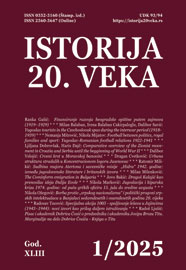URBANA STRUKTURA STRADALIH U KONCENTRACIONOM LOGORU JASENOVAC
URBAN STRUCTURE OF THE VICTIMS IN THE JASENOVAC CONCENTRATION CAMP
Author(s): Dragan CvetkovićSubject(s): Fascism, Nazism and WW II, History of the Holocaust, History of Antisemitism
Published by: Institut za savremenu istoriju, Beograd
Keywords: NDH; urban structure; settlements; cities; Jasenovac; Serbs; Croats; Muslims; Jews; Roma
Summary/Abstract: Based on the results of the partially revised List "Victims of the War 1941-1945", the paper covers the hitherto completely unexplored topic of the urban structure of civilian losses from the territory of the NDH. In an extremely rural environment such as the NDH, most of the civilians who died (86.11%) came from settlements with up to five thousand inhabitants. The largest part of the civilians who died in Jasenovac concentration camp (80.43%) also came from settlements where up to five thousand inhabitants lived, which was 1.07 times less representation in the losses than their participation in the population of the NDH (85.94%). Residents of Zagreb and Sarajevo represented the largest victims of the Jasenovac camp with 10.75 of the losses in the camp, as their representation in the losses was 2.26 times higher than their participation in the NDH population (4.75%). With that, Jasenovac stood out as a place of suffering for the inhabitants of big cities, since the losses of civilians from the two largest cities were realistically 2.42 times higher than the losses of civilians who came from settlements with less than five thousand inhabitants. The role of Jasenovac in the destruction of civilians from settlements of different sizes was not equal. From all civilian victims from the two largest cities, 36.88% lost their lives in Jesenovac, while, on the other hand, only 22.91% of all victims from settlements with less than five thousand inhabitants died in that camp. Nine tenths of the Serbs and Roma who died in Jasenovac came from settlements of up to five thousand inhabitants, two-thirds of Croats and three-fifths of Muslims, while only one-seventh of the victims were Jews. On the other hand, three-fifths of the Jews, one-fifth of the Croats and one-eighth of the Muslims who died in Jasenovac came from the two largest cities. Jews represented four-fifths of the losses of the civilians from the two largest cities, while Serbs accounted for three-quarters of the civilian losses from settlements of less than five thousand inhabitants.
Journal: Istorija 20. veka
- Issue Year: 2025
- Issue No: 1
- Page Range: 93-123
- Page Count: 32
- Language: Serbian

